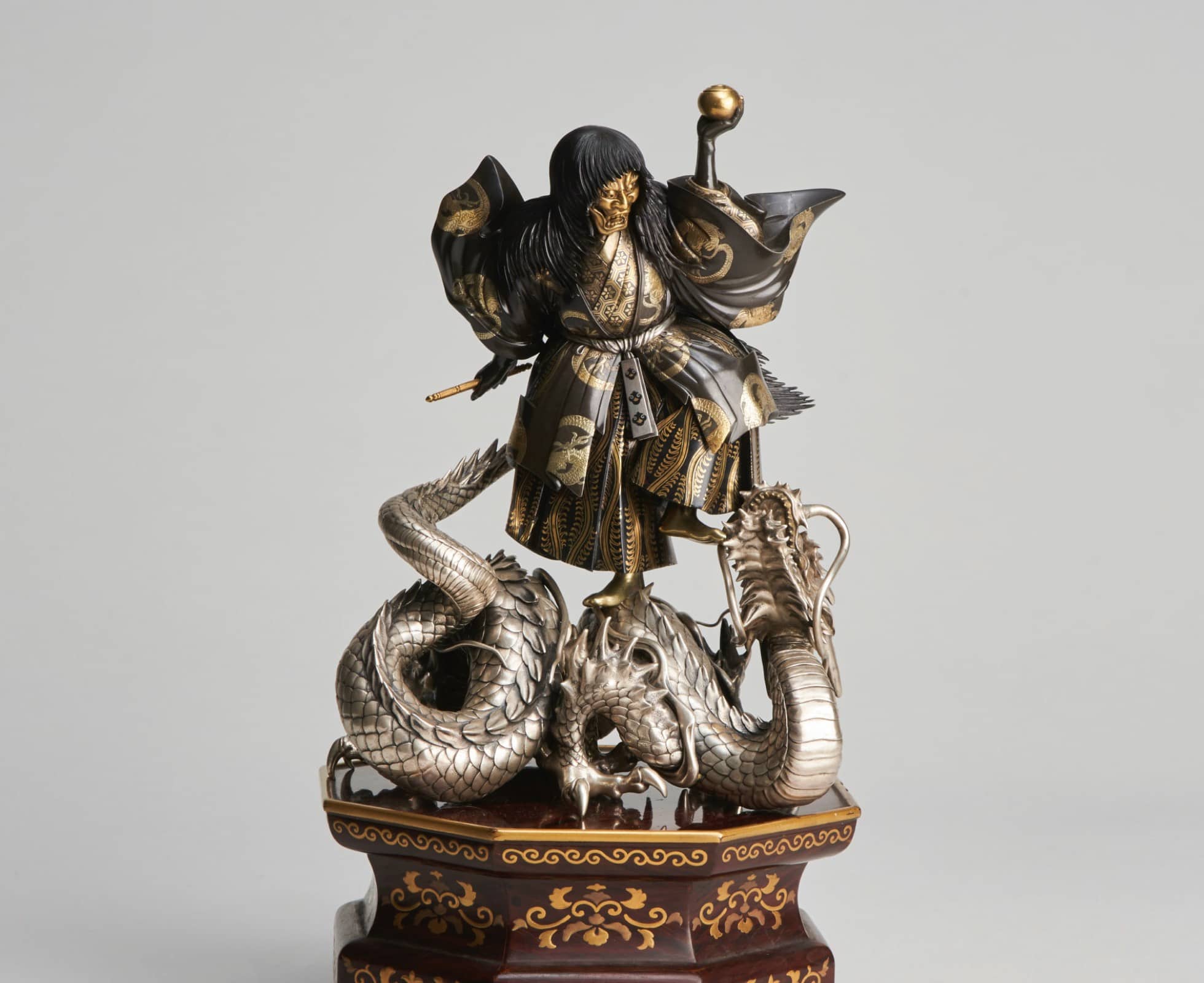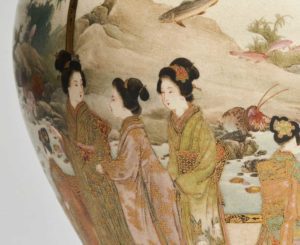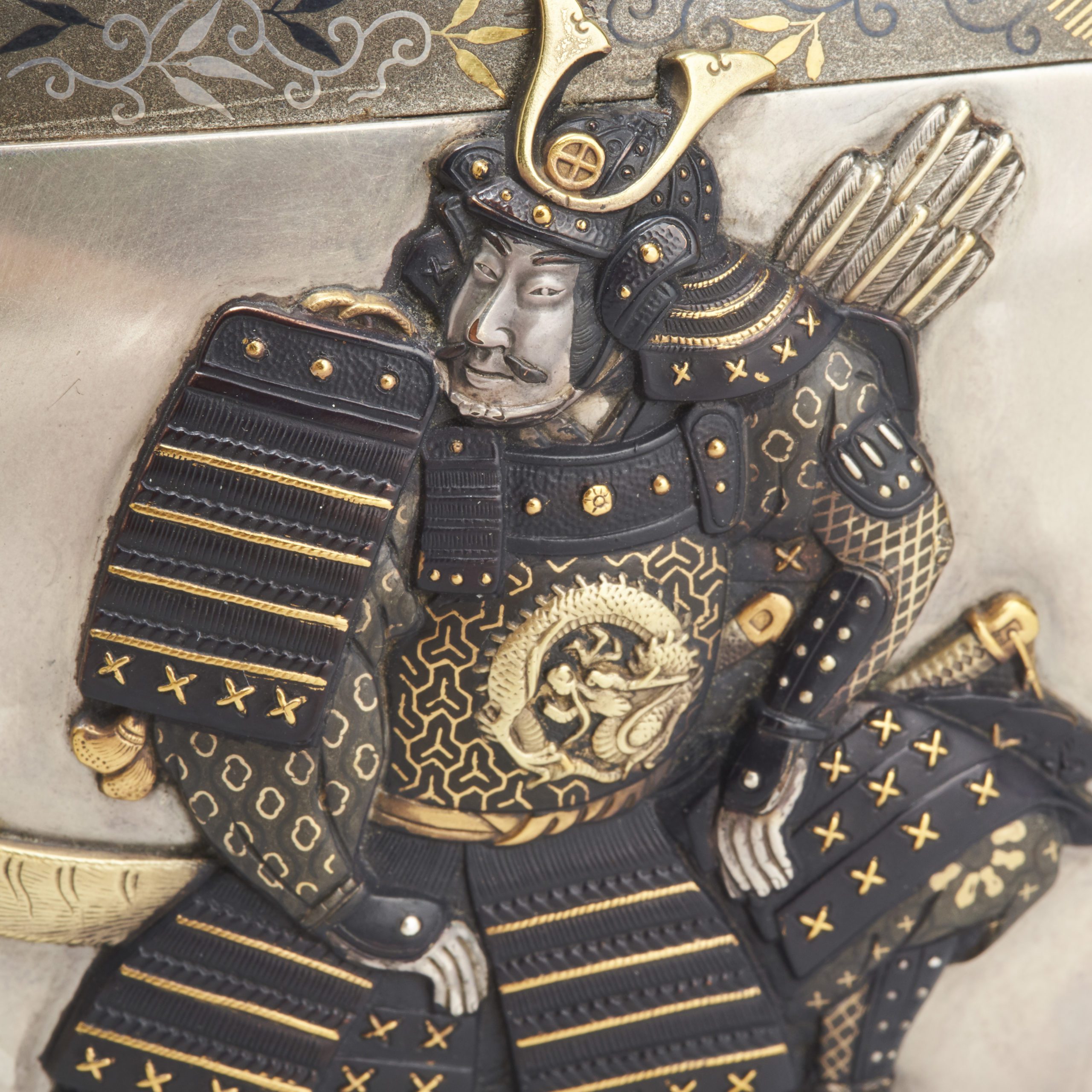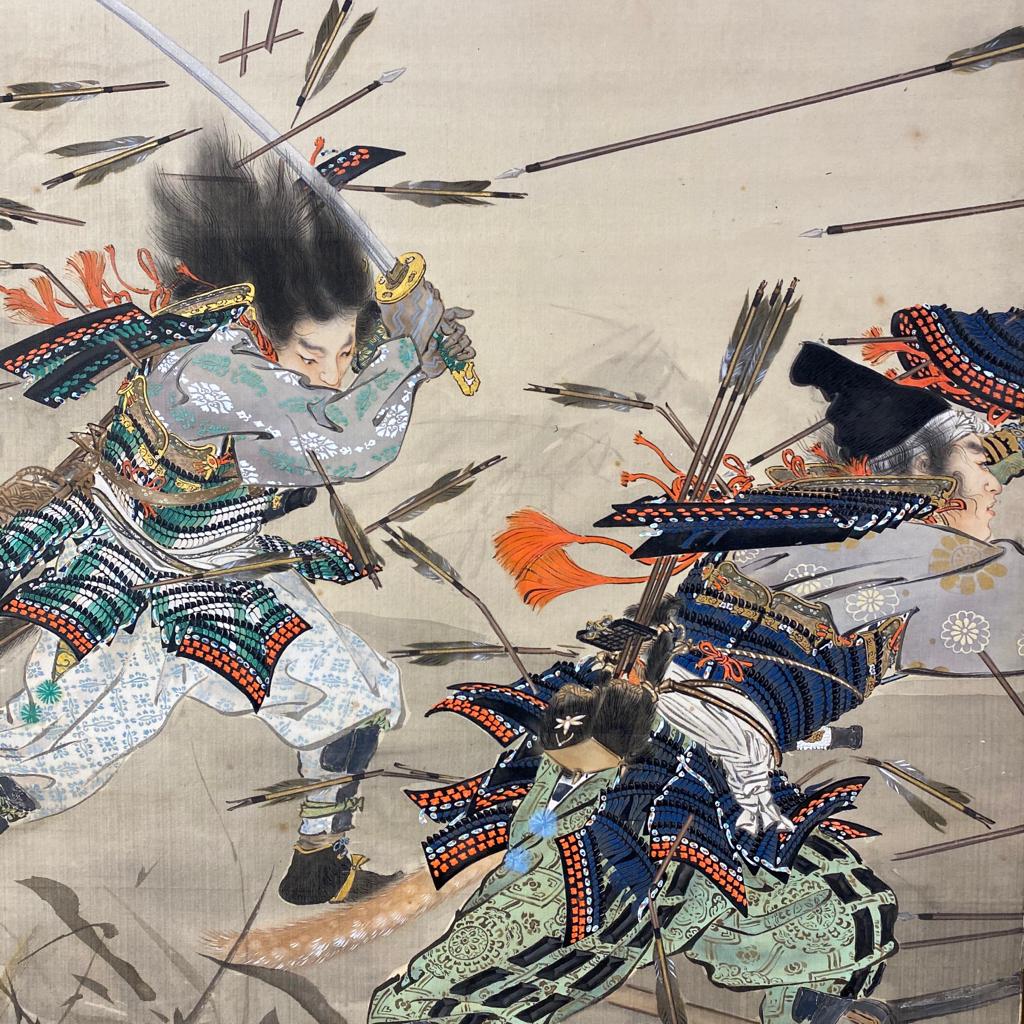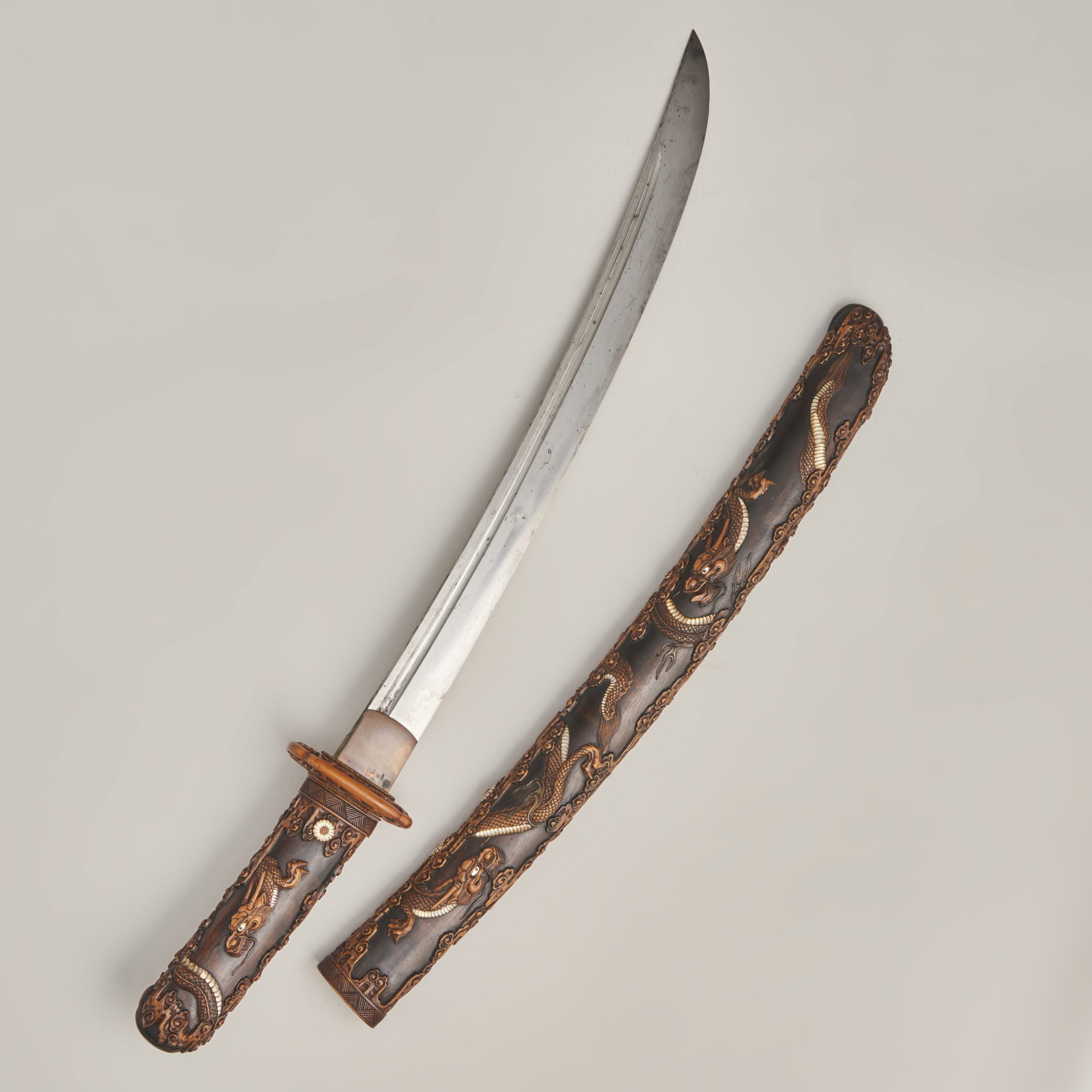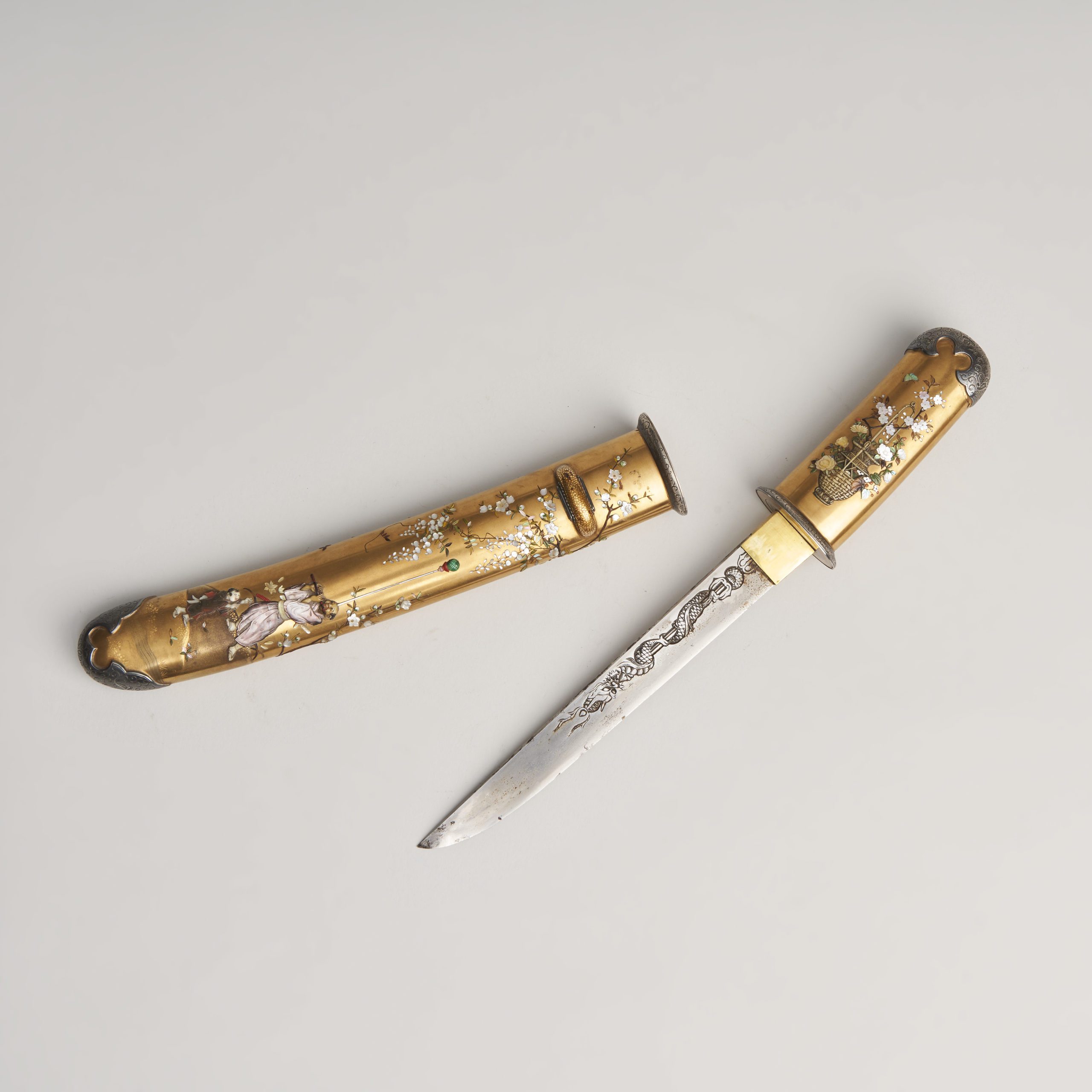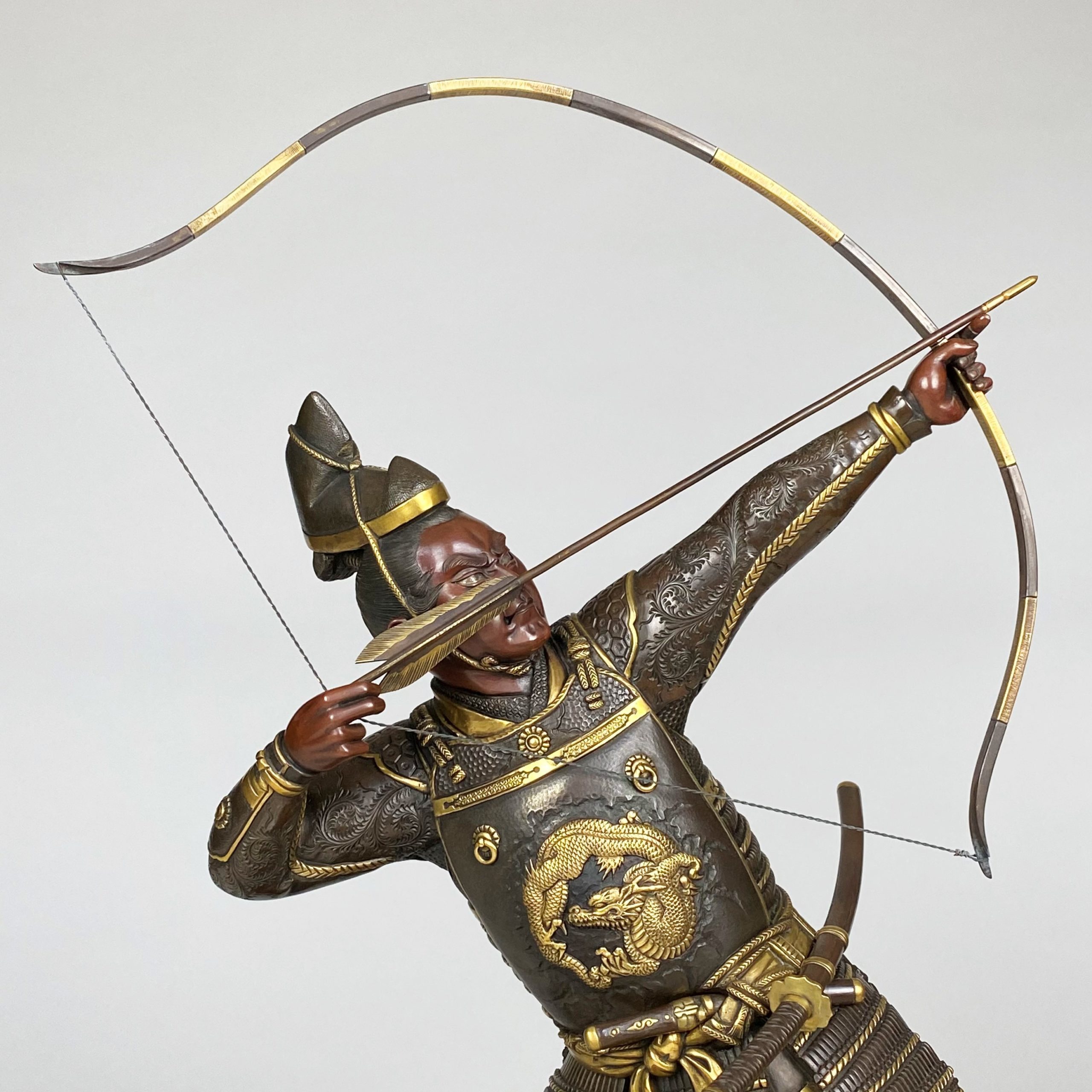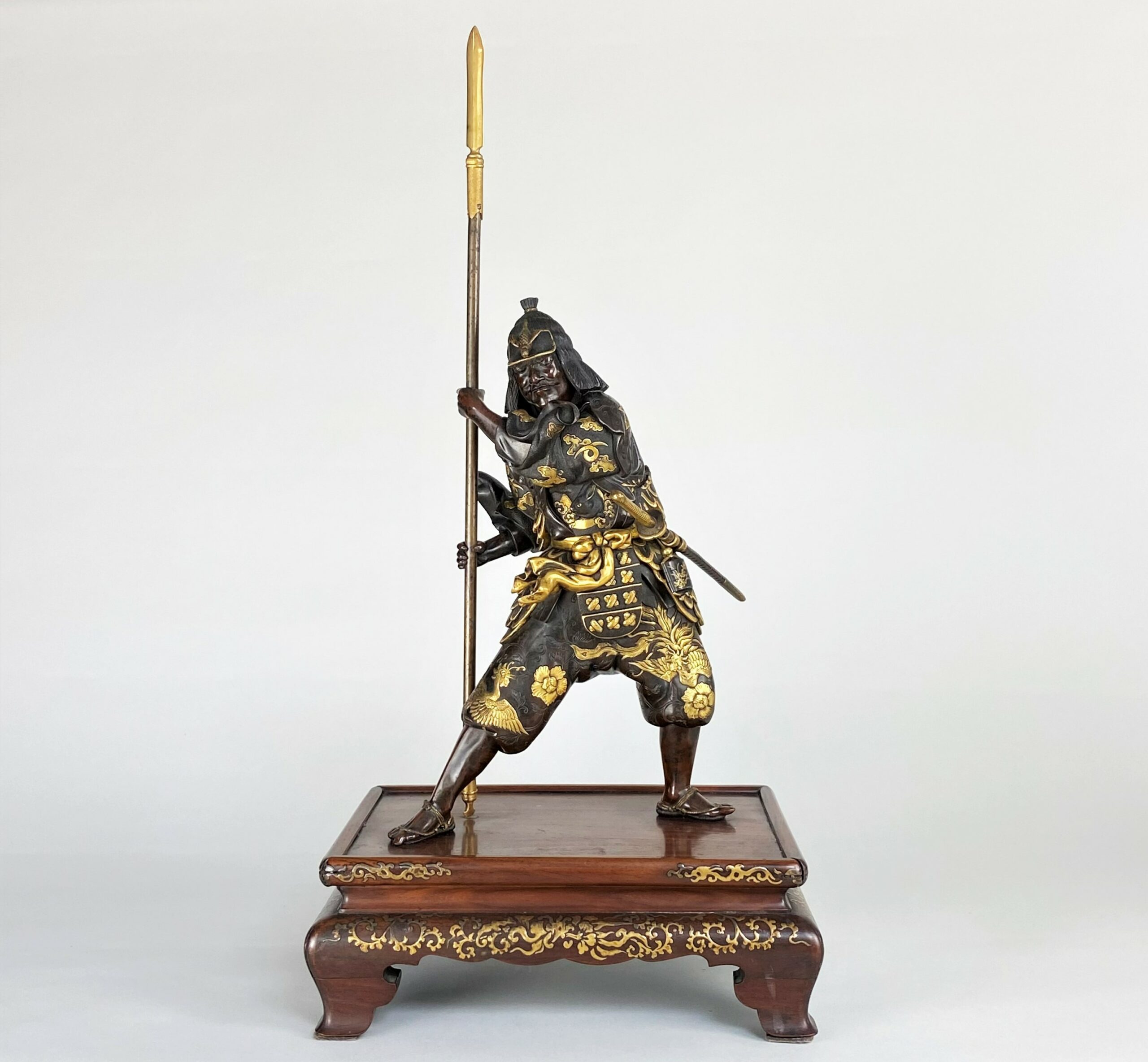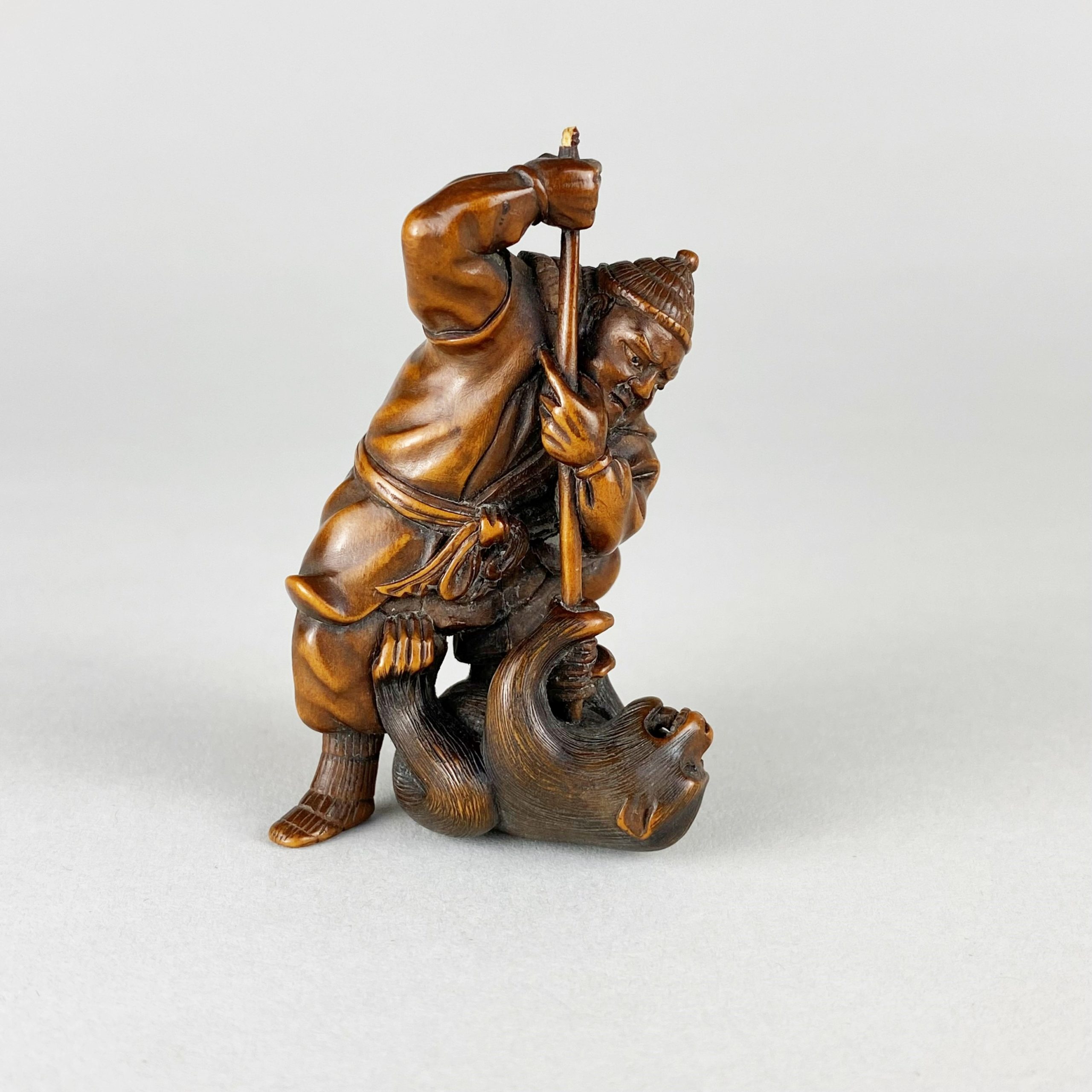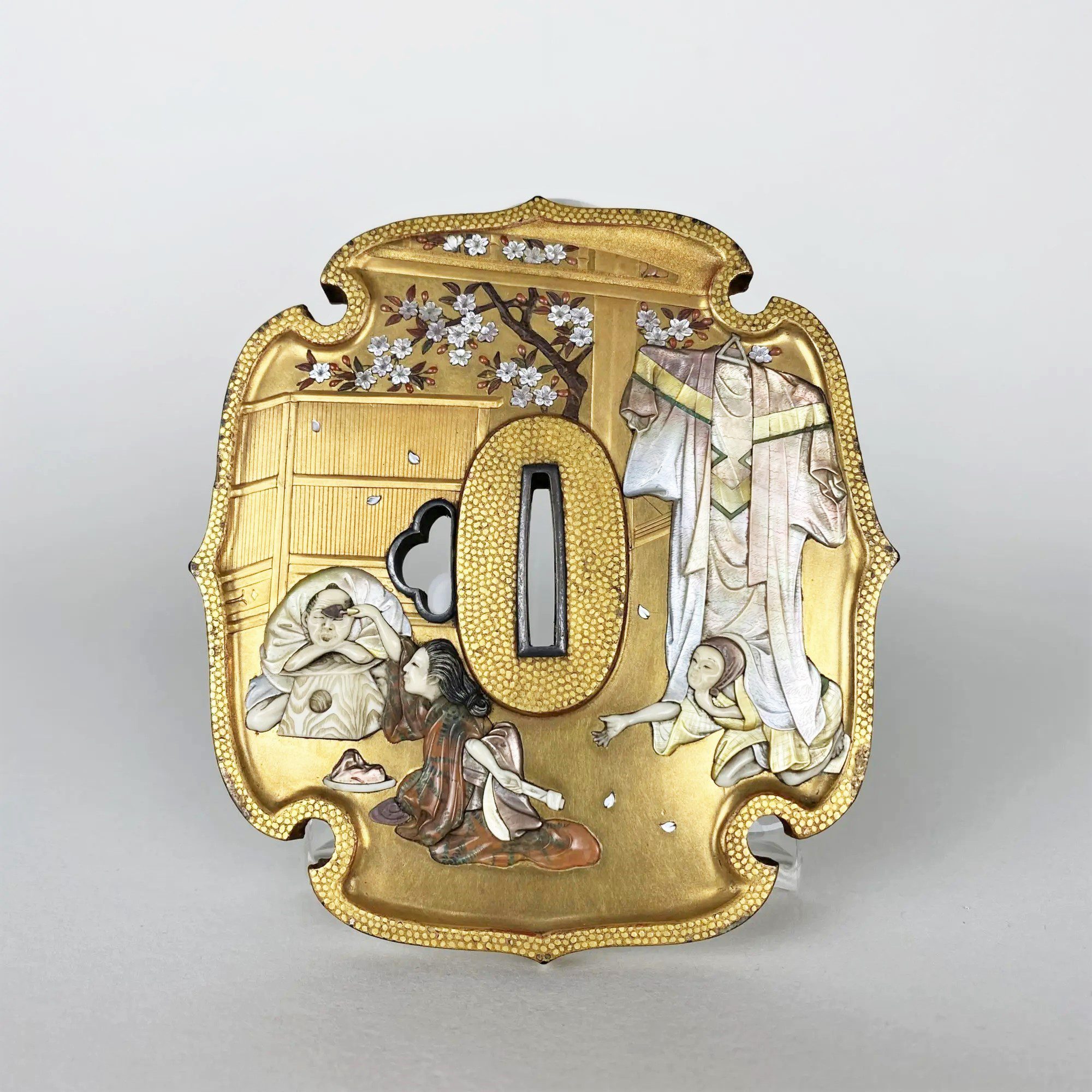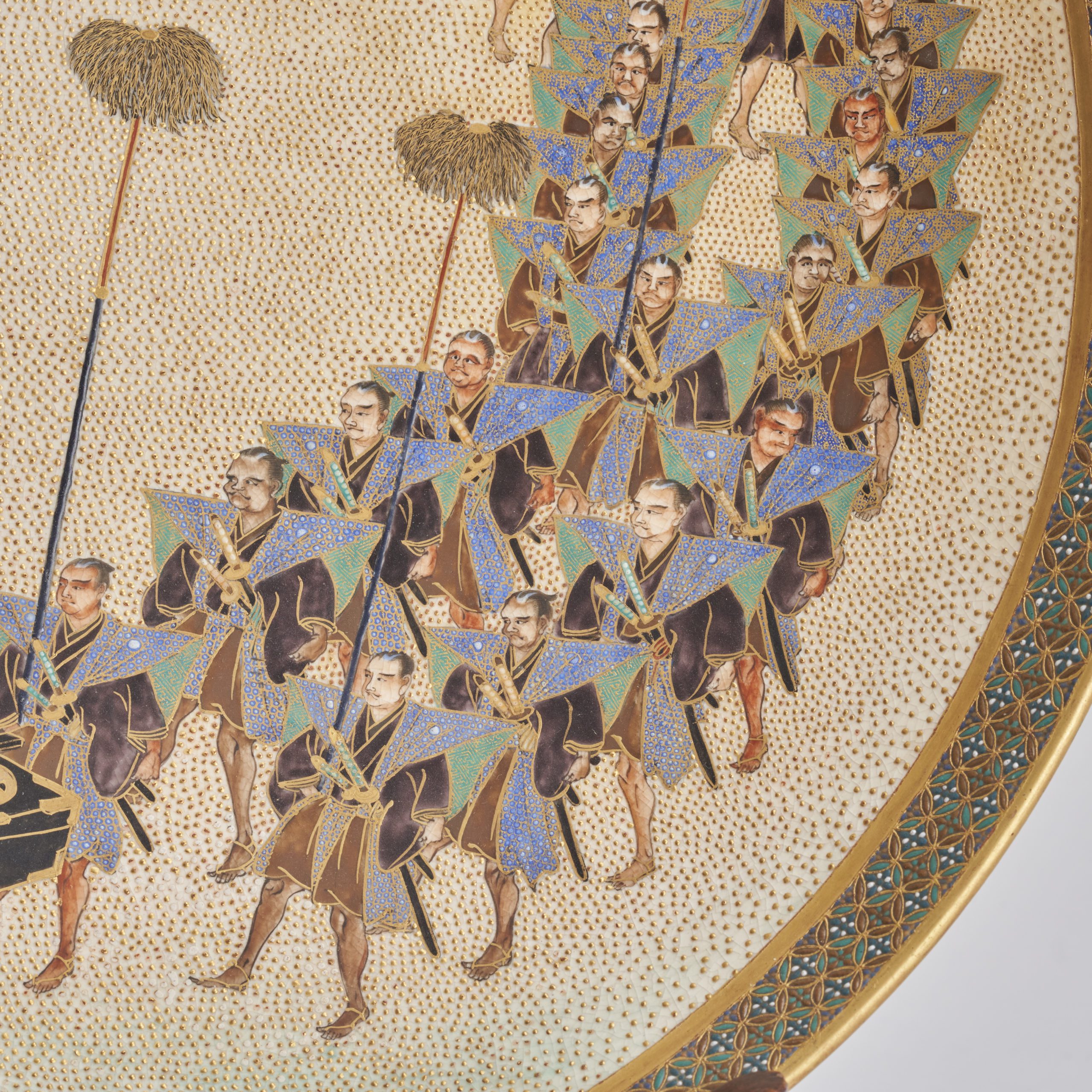The legendary Samurai of Japan were a hereditary, military, nobility Caste that played a very important role in the shaping and ruling of Japan form the 12th Century through to their abolition with the Meiji Restoration, (1868 – 1912).
In Japan, Samurai are known as “Bushi” – (meaning Warrior). Bushi would often be associated with a Clan or Lord and they were highly trained officers in Combat and Military strategy. They lived by the code of the Bushido (The Way of the Warrior), which was Confucian in origin.
Detail on a wonderful Silver and multi-metal Koro, depicting a Samurai warrior clad in armour
The Bushido taught and practiced Loyalty, Self-Discipline and Respect and Samurai Warriors used many weapons including spears, bows and arrows and later on, even guns. They are most famous though for their swords.
The right to own and carry swords was a privilege granted to the Samurai. Commoners would be allowed to own smaller swords (see Wakizashi) for defence but they wouldn’t be permitted to wear them in public. Typically, a warrior would carry a Daisho (pair) of swords with one being larger than the other. There are many sizes and classes of Samurai swords but the most common pairing would have been the Katana and the Wakizashi.
Samurai weaponry is a fascinating and specialist subject. Whilst we generally don’t deal in armoury per se, we do have a small collection of swords and sword fittings and a wide range of Japanese Samurai weaponry features in many pieces across our collection of late 19th Century Fine Art and Antiques.
You can click on any of the images for more information regarding any of the pieces featured in this blog. We hope you enjoy the read…
Detail on a stunning, Monumental pair of Japanese, Meiji-era screens depicting a famous Battle during the Genpei War
Katana (Uchigatana)
Of all the Japanese weapons, the Katana is perhaps the most revered and recognisable. In Japan, what we think of as a Katana is actually known as the Uchigatana. (Katana actually just translates to any single edged sword.) They are generally between 60 and 80cm in length.
The classical long slightly curved form was first developed around 1100AD and hasn’t changed much in over 900 years. One of the reasons for this supposed lack of innovation was that until 1868, Japan was a feudal country resisting influence from outside. We believe that it is actually remarkable that the design didn’t evolve for such a long period of time. It certainly contributes to its status and reputation in the West.
The Katana was a symbol of the Samurai and a weapon of last resort. It was often made from pig iron which has a high level of impurities. As such, blades were made by pattern welding (repeatedly folding the metal) to create a very sharp but brittle edge which could then be combined with a central strip of stronger metal to create a blade. This technique of manufacture was only adopted by the Japanese in the 1200’s whereas Western Civilisations such as the Celts had been using this method 200 years earlier.
A Bronze Okimono depicting a Warrior yielding his Katana
Wakizashi
The Wakizashi is the smaller cousin of the Katana. It is between 30 and 60cm long (between 1 and 2 Shaku). The Wakizashi would have often been worn alongside the Katana as a back-up weapon. It is an auxiliary sword used for close combat fighting. It is important to note though that it is not merely a smaller version of the Katana – it is also forged differently. The Wakizashi was also popular with those who were not of Samurai class as it was the largest sword that they would be legally permitted to carry as a defence. Its name translates as “Side inserted sword” due to it often being worn tucked through the Obi (Sash belt).
A beautiful Wakizashi and Saya with onlaid Dragon decoration
Here we see legendary a masterful Okimono depicting the legendary Samurai Warrior, Yoshitsune (as a child) yielding both a Katana and a Wakizashi as he battles with a pair of Tengu. Click on the image for more information on this wonderful wood carving.
A masterful box wood Okimono depicting Yoshitsune battling with a pair of Tengu
Tanto
Although, technically still a sword the Tanto is used more like a knife. The blade can be single or double edged and is between 15-30cm long (one Shaku). The Tanto is often worn with a Katana or Tachi, (similar to the Katana but older and longer in design). It is traditionally the blade that would have been used for Seppuku, the ritual suicide performed by Samurai
An ornate Gold lacquer Tanto with Shibayama decoration
Yumi
The Japanese word for bow is Yumi. Yumi were a hugely important weapon in the Samurai arsenal. Unlike the Katana, the bow was developed many times until the design reached near perfection in the 17th Century.
The Sengoku period, (1476 – 1603) saw trade with the Portuguese and this brought with it the Matchlock Gun. At this point, the bow was relegated to more of a sporting weapon as opposed to one that would be used in actual combat.
A Bronze Okimono by the Miyao Company and depicting an Archer
Naginata
The Naginata is a form of curved bladed pole. It is the iconic weapon of the Onna-Musha, the Female Samurai. Onna-Musha were members of the warrior class and actually fought alongside the male Samurai. Interestingly, recent archaeological studies across a number of battle sites in Japan show that up to 30% of battle corpses belonged to women. Two of the most legendary and respected female Samurai were Tomoe Gozen and Hangaku Gozen. They are often depicted in stories and artwork.
The Naginata was also used by Warrior Monks and Commoners. They had several advantages over a sword. For example, they could be used to create space on a battle field and of course they had a longer reach.
A fearsome Warrior from an Okimono group by Gyoko
Yari
The Yari is a Japanese straight-headed spear. They differ from the Naginata in that they are straight and not curved. The Yari polearm was used alongside the Yumi (bow) extensively during the Heian period, (794 – 1185). They were one of the staples of the Samurai and were used much more often than swords because of their favourable longer reach and effectiveness against the Cavalry. The length of the pole could vary from 2 to an incredible 6.5 metres.
A fascinating miniature wood carving, depicting a Samurai, possibly using a Yari or similar to finish off a Monkey
Kogatana
A kogatana is not a weapon as such, but is often found as part of a larger sword, it’s a small eating and craft knife which slots through the Tsuba (sword guard) and sits in its own inbuilt sheath.
It would sometimes be paired with a matching Kogai which is a hair styling tool. We sometimes see the knife handles known as Kozuka used as the handles in European cutlery sets.

A Kogatana in situ in a Wood and lacquer Wakizashi

The Kogatana once removed from its fitting
Tsuba
Again, not a weapon but the Tsuba is the hand guard for a Japanese sword. They help to provide balance and to protect the hand from an enemy blade. Elaborate Tsubas can also be a symbol of status and social ranking. Tsuba have become collectible works of art in their own right.
A beautiful Gold lacquer Tsuba
We hope you have enjoyed this blog post. You can read more from our “Stories behind the Art” series by clicking here.
Note, we don’t deal in functional blades. All our items are antique artifacts over 100 years in age.
A Samurai procession on a Satsuma dish by Meizan

